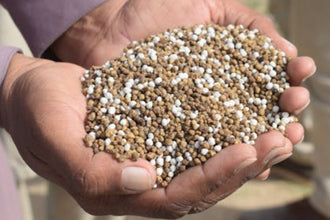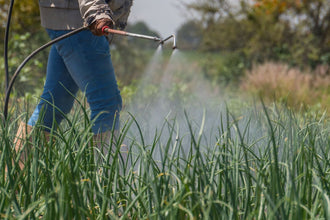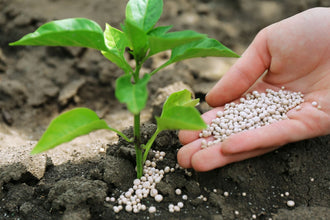
Winter fertilizer gives your plants the nutrients they need to survive cold weather and thrive when spring returns. Most gardeners make the mistake of stopping all fertilization once temperatures drop. But smart winter feeding can mean the difference between plants that barely survive and those that bounce back stronger than ever.
Cold weather doesn't mean your garden goes to sleep completely. Root systems stay active even when everything above ground looks dormant. Plants use this quiet time to build energy reserves and strengthen their root networks. The right winter fertilizer helps support these underground processes that set the stage for explosive spring growth.
Why Plants Need Winter Fertilizer
Winter brings unique challenges that stress plants in ways most people don't consider. Temperature swings freeze and thaw the soil repeatedly. This process damages root systems and leaches valuable nutrients away from plants. Wind and cold also create ongoing stress that depletes stored energy.
Plants preparing for winter need specific nutrients to build strong cell walls and concentrate sugars in their tissues. These natural antifreeze compounds help prevent ice crystal formation inside plant cells. Without adequate nutrition, plants can't produce enough of these protective substances.
Many gardeners assume fertilizing in winter will stimulate new growth that cold weather will damage. This misconception leads to weak, undernourished plants. The truth is that proper winter fertilizer focuses on root development and energy storage rather than leaf and stem growth.
Root Development During Cold Months
Underground activity continues even when surface growth stops completely. Roots extend deeper and spread wider during winter months. This expansion helps plants access water and nutrients in lower soil layers where temperatures stay more stable.
Winter fertilizer supports this root growth with phosphorus and potassium rather than nitrogen. These nutrients strengthen root systems without triggering vulnerable new shoots. Strong roots mean better drought tolerance and nutrient uptake when growing season returns.
Building Energy Reserves
Plants store energy in their root systems during dormant periods. These reserves fuel the first burst of spring growth before photosynthesis kicks into full gear. Winter fertilizer helps plants accumulate more stored energy for a stronger start next season.
Organic fertilizers work particularly well for winter feeding because they release nutrients slowly. This gradual release matches how plants actually use nutrients during cold months. Fast-acting synthetic fertilizers can overwhelm dormant plants and cause more harm than good.
Choosing the Right Winter Fertilizer
Different plants need different winter nutrition strategies. Trees and shrubs require different feeding than perennial flowers or evergreen plants. Understanding these differences helps you select the most effective winter fertilizer for each area of your garden.
Organic options typically work better than synthetic fertilizers for winter applications. Natural fertilizers release nutrients gradually as soil temperature and moisture allow. This prevents nutrient burns and matches seasonal plant needs more closely.
Look for fertilizers with low nitrogen content and higher phosphorus and potassium levels. A balanced organic fertilizer with moderate NPK ratios provides steady nutrition without overstimulating growth. Winter fertilizer should feed the soil ecosystem as much as the plants themselves.
NPK Ratios for Winter Applications
Nitrogen promotes leaf and stem growth that cold weather can easily damage. Winter fertilizer should contain minimal nitrogen to avoid triggering tender new shoots. Instead, focus on phosphorus for root development and potassium for cold tolerance.
Phosphorus supports root expansion and energy storage during dormant months. This nutrient becomes less available in cold soil, so winter applications help maintain adequate levels. Strong root systems developed during winter support vigorous spring growth.
Potassium improves plant cell structure and helps regulate water movement within plant tissues. These functions become critical for cold tolerance and prevent freeze damage. Winter fertilizer rich in potassium helps plants survive temperature extremes.
Organic vs Synthetic Options
Organic winter fertilizer offers several advantages over synthetic alternatives. Natural materials improve soil structure and feed beneficial microorganisms that support plant health. These soil improvements continue working long after the fertilizer application.
Synthetic fertilizers can burn plant roots in cold conditions when soil microbe activity slows down. Organic materials break down gradually and rarely cause nutrient burns. They also improve water retention and drainage, which helps prevent root rot in wet winter conditions.
Compost, aged manure, and other organic materials serve as excellent winter fertilizer bases. These materials provide slow-release nutrition while improving soil structure. Adding specific organic fertilizers can boost nutrient levels for plants with higher needs.
Timing Winter Fertilizer Applications
Application timing makes the difference between effective winter fertilizer and wasted effort. Apply fertilizer too late and plants can't absorb nutrients before soil freezes. Apply too early and nutrients may leach away before plants need them most.
The best window for winter fertilizer application starts about 6-8 weeks before your average first hard frost. This timing allows plants to absorb and store nutrients before entering full dormancy. Late fall applications work better than early winter feeding in most climates.
Regional climate variations affect optimal application timing significantly. Southern gardeners may continue fertilizing through winter months. Northern regions typically need all applications completed before soil freezes solid. Understanding your local climate helps optimize winter fertilizer timing.
Pre-Frost Applications
Apply winter fertilizer while soil temperatures remain above 40 degrees Fahrenheit. Nutrient uptake slows dramatically in colder soil conditions. Plant roots need time to absorb and transport nutrients before freezing temperatures arrive.
Water thoroughly after applying winter fertilizer to begin the nutrient release process. Moisture activates organic fertilizers and helps distribute nutrients through the root zone. Avoid fertilizing during drought conditions when plants can't effectively use added nutrients.
Monitor weather forecasts before making winter fertilizer applications. Avoid fertilizing right before heavy rain that could wash nutrients away. Light moisture helps activate fertilizer, but excessive water causes nutrient loss.
Regional Climate Considerations
Cold climate gardeners should complete winter fertilizer applications by early fall. Soil freezes earlier and stays frozen longer in northern regions. Plants enter dormancy sooner and need nutrition established before this happens.
Warm climate gardeners can extend winter fertilizer applications through the season. Plants in mild winter areas continue some growth and nutrient uptake. Monthly light applications often work better than single heavy doses.
Coastal areas with moderate winter temperatures allow flexible winter fertilizer schedules. Ocean influence moderates temperature swings and extends the effective application window. Monitor soil temperature rather than air temperature for best timing.

Application Methods and Best Practices
Proper application technique ensures winter fertilizer reaches plant roots effectively. Broadcasting granular fertilizer over large areas works well for lawns and groundcover plants. Individual plant feeding requires more targeted approaches.
Work granular winter fertilizer into the top few inches of soil when possible. This placement puts nutrients closer to feeder roots where uptake occurs. Avoid disturbing deeper roots during cultivation around established plants.
Liquid fertilizer applications can supplement granular winter fertilizer programs. Foliar feeding works well for evergreen plants that continue photosynthesis during winter months. Apply liquid fertilizers during warm afternoon periods for best absorption.
Granular Application Techniques
Spread granular winter fertilizer evenly using a broadcast spreader for large areas. Hand spreading works fine for small gardens but requires careful attention to coverage. Uneven application creates areas of over and under fertilization.
Water granular fertilizer immediately after application to begin nutrient release. This watering also prevents fertilizer burn on plant foliage where granules might have landed. Light irrigation works better than heavy soaking that washes nutrients away.
Calculate application rates based on actual garden area rather than guessing. Over-application wastes fertilizer and can harm plants. Under-application fails to provide needed nutrition for winter preparation and spring growth.
Liquid Fertilizer Benefits
Liquid winter fertilizer provides immediate nutrient availability for rapid uptake. This quick action helps plants preparing for dormancy get needed nutrition quickly. Liquid applications also distribute more evenly than granular fertilizers.
Mix liquid concentrates according to label directions for winter applications. Stronger concentrations can burn plant roots in cold conditions when growth slows. Weaker solutions applied more frequently often work better than single strong doses.
Apply liquid winter fertilizer to soil rather than plant foliage in most cases. Soil applications feed roots directly and avoid potential leaf burn. Save foliar feeding for evergreen plants that benefit from direct nutrient absorption through leaves.
Fancy Chicken Fertilizer: Organic Winter Protection That Works
Organic chicken manure provides the ideal winter fertilizer approach for gardeners who want to protect plants naturally while building soil health. Fancy Chicken's 4-2.5-2 NPK formula delivers the perfect balance for winter feeding - enough nutrition to support root development without triggering vulnerable new growth. This gentle organic approach helps plants survive harsh conditions while creating stronger soil for spring.
Gradual Nutrient Release for Cold Weather Conditions
The organic nature of Fancy Chicken fertilizer makes it perfect for winter applications. Unlike synthetic fertilizers that can overwhelm dormant plants, chicken manure releases nutrients slowly as soil microbes break it down. This controlled release matches how plants actually absorb nutrients during cold months when root activity slows significantly.
Cold soil conditions reduce microbial activity that activates organic fertilizers. This natural slowdown prevents nutrient overload while maintaining steady nutrition throughout winter months. Plants get exactly what they need when they need it, without the stress of excess fertilizer in their systems.
The moderate phosphorus content in Fancy Chicken fertilizer supports root expansion during winter without overstimulating growth. Strong root systems developed with organic nutrition provide better cold tolerance and improved spring performance. Plants emerge from winter with deeper, more extensive root networks.
Building Soil Structure While Plants Rest
Winter applications of Fancy Chicken fertilizer improve soil conditions during the dormant season. The organic matter feeds beneficial soil microbes that work slowly in cold conditions. These microbes create better soil structure that helps plants survive freeze-thaw cycles and improves spring growing conditions.
Here's how Fancy Chicken creates better winter growing environments:
-
Improves water drainage in heavy soils that can freeze and damage roots
-
Increases organic matter that insulates root systems from temperature extremes
-
Feeds soil biology that continues working slowly throughout winter months
-
Reduces soil compaction from freeze-thaw cycles that stress plant roots
-
Stores nutrients safely until plants can use them effectively in spring
-
Creates stable soil structure that resists erosion from winter weather
Safe Application for Dormant Plants
The gentle nature of Fancy Chicken fertilizer makes it nearly impossible to burn dormant plants during winter applications. Chemical fertilizers can accumulate in cold soil and damage roots when spring warming occurs. Organic chicken manure eliminates this risk while providing steady nutrition.
Apply Fancy Chicken fertilizer 6-8 weeks before your first hard frost for best results. Work 2-3 pounds per 100 square feet into garden beds around trees, shrubs, and perennial plants. The organic matter will begin breaking down slowly, providing nutrition that lasts throughout the dormant period.
Container plants benefit from light Fancy Chicken applications before moving them to protected winter locations. Mix about 1/4 cup into the soil surface of large containers. This gentle feeding supports root health during the stressful winter storage period.
Supporting Natural Cold Tolerance
Plants develop natural antifreeze compounds when they receive proper nutrition before winter arrives. Fancy Chicken fertilizer provides the building blocks plants need to create these protective substances. Well-fed plants survive temperature extremes better than those entering winter in a weakened state.
The potassium in organic chicken manure plays a crucial role in cold tolerance. This nutrient helps plants regulate water movement in their tissues and strengthens cell walls against freeze damage. The natural potassium in Fancy Chicken fertilizer works more effectively than synthetic sources because it releases gradually.
Nitrogen levels in Fancy Chicken fertilizer stay moderate enough to avoid triggering tender new growth. Too much nitrogen before winter creates soft tissue that cold weather easily damages. The balanced approach prevents this problem while maintaining plant health through the dormant season.
Long-Term Soil Building Benefits
Each winter application of Fancy Chicken fertilizer adds organic matter that improves soil for years to come. This cumulative effect creates growing conditions that support healthier plants and better cold tolerance over time. Gardens fed with organic fertilizer become more resilient with each passing season.
The slow decomposition of organic matter provides benefits that extend far beyond immediate plant nutrition. Improved soil structure, better water retention, and increased biological activity all contribute to stronger plant communities that withstand winter stress more effectively.
Fancy Chicken fertilizer applications during dormant seasons often work better than spring feeding for long-term soil improvement. Plants aren't competing for nutrients, so more organic matter goes toward soil building. Spring growth benefits from these soil improvements plus any remaining available nutrients.
Your Garden Deserves Year-Round Care
Winter represents a critical opportunity to strengthen your garden's foundation while plants rest and recharge for spring. The nutrition choices you make during dormant months determine whether your plants simply survive or thrive when growing season returns. Proper winter feeding creates the underground strength that supports spectacular spring growth and season-long plant health.
Your plants depend on winter nutrition to build the root systems and energy reserves that fuel their best performance. Fancy Chicken fertilizer provides the organic approach that protects plants naturally while creating better growing conditions season after season. Give your garden the winter care it deserves with Fancy Chicken's gentle, effective organic nutrition that works with nature to create stronger, healthier plants year after year.








